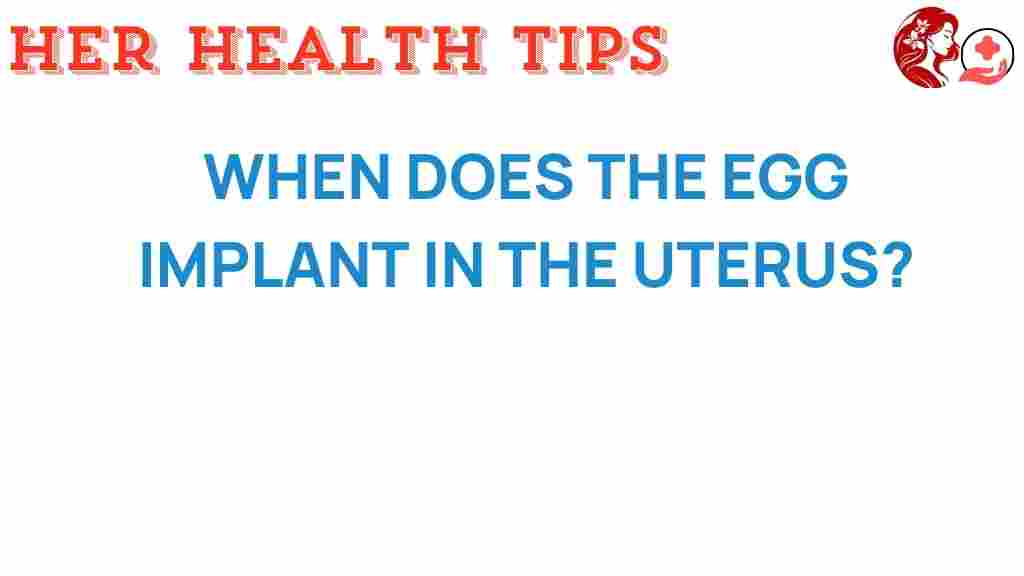Understanding When the Egg Implants in the Uterus: The Process of Egg Implantation
Understanding the process of egg implantation is crucial for anyone interested in reproductive health and fertility. This complex yet fascinating journey begins with ovulation, where a mature egg is released from the ovary and makes its way through the fallopian tube to the uterus. This article will take a deep dive into the stages of conception, the role of the uterine lining, and the timing of implantation, while also addressing common questions surrounding these topics.
The Menstrual Cycle and Ovulation
The menstrual cycle is a monthly process that prepares a woman’s body for potential pregnancy. It consists of several phases:
- Menstrual Phase: The cycle begins with menstruation, where the uterine lining sheds if no fertilization occurs.
- Follicular Phase: After menstruation, the body prepares to release an egg from the ovary. Follicle-stimulating hormone (FSH) stimulates the growth of follicles.
- Ovulation: Approximately midway through the cycle, around day 14 in a typical 28-day cycle, a surge in luteinizing hormone (LH) triggers the release of a mature egg.
- Luteal Phase: After ovulation, the ruptured follicle transforms into the corpus luteum, which releases hormones to support the uterine lining.
Understanding these phases is essential for anyone tracking their fertility or attempting to conceive.
The Journey of the Egg Post-Ovulation
Once ovulation occurs, the egg travels down the fallopian tube. If sperm is present, fertilization may occur, resulting in the formation of an embryo. However, fertilization is just the beginning of the journey towards pregnancy.
What is Egg Implantation?
Egg implantation refers to the process where a fertilized egg, or embryo, attaches itself to the uterine lining. This crucial step typically occurs about 6 to 10 days after fertilization, marking the transition from a fertilized egg to a developing embryo. Successful implantation is essential for pregnancy to occur.
The Uterine Lining: Its Role in Implantation
The uterine lining, or endometrium, plays a critical role in egg implantation. During the menstrual cycle, the lining thickens in preparation for a potential pregnancy. Key points about the uterine lining include:
- Thickness: A healthy uterine lining should be thick enough to support implantation. Typically, a lining of about 7-14 mm is considered optimal.
- Hormonal Influence: Hormones such as estrogen and progesterone are vital for maintaining the uterine lining during the luteal phase.
- Receptivity: The uterine lining must be receptive to the embryo for successful implantation to occur.
When Does Egg Implantation Occur?
Timing is everything when it comes to conception and egg implantation. Here’s a breakdown of when egg implantation typically occurs in relation to the menstrual cycle:
- Ovulation Day: This is typically around day 14 of a 28-day cycle.
- Fertilization: If sperm is present, fertilization happens within 12-24 hours after ovulation.
- Embryo Development: After fertilization, the embryo begins to divide and develop as it travels to the uterus.
- Implantation Window: Implantation usually occurs between days 6 to 10 post-ovulation, which would be days 20 to 24 of a 28-day cycle.
This timeline can vary slightly depending on the individual’s cycle length and health conditions.
Signs of Implantation
Many women wonder if they can detect signs of implantation. Here are some common symptoms that may indicate successful implantation:
- Spotting: Light spotting or bleeding, known as implantation bleeding, may occur when the embryo attaches to the uterine lining.
- Cramps: Mild cramping can happen as the uterus adjusts.
- Changes in Basal Body Temperature: A rise in basal body temperature may indicate hormonal changes following implantation.
- Pregnancy Symptoms: Early symptoms of pregnancy, such as nausea and breast tenderness, may start to appear.
Challenges in Egg Implantation
While many women can conceive naturally, some may face challenges with egg implantation. Common factors affecting implantation include:
- Endometrial Factors: A thin or poorly developed uterine lining can hinder implantation.
- Hormonal Imbalances: Disorders affecting hormone levels can disrupt the menstrual cycle and impact implantation.
- Structural Issues: Conditions like fibroids or polyps in the uterus can interfere with implantation.
- Age: As women age, fertility and the likelihood of successful implantation can decrease.
Improving Your Chances of Successful Implantation
For those trying to conceive, there are several steps you can take to improve your chances of successful egg implantation:
- Maintain a Healthy Diet: A balanced diet rich in vitamins and minerals supports reproductive health.
- Regular Exercise: Physical activity can help regulate hormones and improve overall health.
- Manage Stress: High-stress levels can negatively impact fertility; consider relaxation techniques.
- Track Your Cycle: Use apps or calendars to monitor ovulation and the fertile window.
- Consult a Healthcare Provider: If experiencing difficulties, seek guidance from a specialist in reproductive health.
For more detailed information on improving fertility, you can visit this resource.
Conclusion
Understanding egg implantation is a vital aspect of reproductive health and fertility. By learning about the menstrual cycle, ovulation, and the significance of the uterine lining, women can better navigate their journey towards conception. While challenges may arise, taking proactive steps to support reproductive health can enhance the likelihood of successful pregnancy. Always consult with a healthcare professional for personalized advice and support in your fertility journey.
For more information about women’s health and fertility resources, feel free to explore this link.
This article is in the category Reproductive and created by HerHealthTips Team
